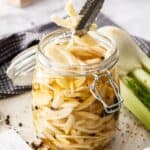
Pickled Fennel
You will find many ways to enjoy this easily made, quick Pickled Fennel. Minimal effort is required to make these crunchy, tangy pickles that are ideal for pairing with meat, fish or poultry. As well, they are a great addition to a grazing platter, salads or sandwiches for additional flavour and texture! You just add the thinly sliced fennel to a sterilised jar and pour over the brightly flavoured brine. Seal the jar, refrigerate the pickles, and after a short time, they are ready to eat. It doesn’t come much better or easier than that!
Servings 1 800ml (27 fluid oz) Jar
Calories 313kcal
Equipment
- 1 x 800ml (27 fluid oz) Jar
Ingredients
- 400 g (14 oz) fennel - prepared weight, approx. 1 large bulb. See Note 1
- 2 teaspoon sea salt See Note 2
- 1 cup (250 ml) white vinegar See Note 3
- ¾ cup (180 ml) water See Note 4
- 2 ½ tablespoon sugar See Note 5
- 1 teaspoon whole yellow mustard seeds
- 1 teaspoon whole black peppercorns
- ¼ teaspoon red chilli pepper flakes
Instructions
To Sterilise the Jars:
- Sterilise the jar or jars you'll be using to store the pickles. Choose glass jars with an airtight, metal lid and ensure they have been washed by hand in hot soapy water then rinsed well. Check that the metal lids do not have rubber inserts – if they do, allow them to air dry, instead of placing in the oven.Preheat the oven to 130 Degrees C (270 F) and place the jars in the oven for 15-20 minutes. Keep the jars warm.
For the Pickled Fennel:
- Wash and dry the fennel. Trim the top and base of the fennel bulb and set aside- keep these for stocks or sauces. Remove any of the coarse outer leaf of the bulb.
- Cut the fennel in half lengthways and then in half again. Remove the core from each piece of fennel.
- Using a sharp knife or a mandolin cut the fennel into thin strips – I aim for ¼ cm.
- In a small non-reactive saucepan, combine the water, vinegar, sugar and seasonings. Stir over medium heat to dissolve the sugar, bring to the boil and remove from the heat. (See Note 6).
- Add the fennel to the sterilised jar, top with the pickling liquid and seal with the lid immediately.
- Allow the jar to cool on your bench before placing in the refrigerator.
- The Pickled Fennel can be consumed once cool, but it is best to leave for 12-24 hours for the flavours to develop.
Notes
- Fennel: ensure your fennel is fresh and crisp.
- Cooking sea salt: ensure you use cooking salt or coarse sea salt. Regular table salt may contain anti-caking agents and is much stronger.
- Vinegar: I have used white vinegar that is 5% in acidity. You can also use apple cider or white wine vinegar – just ensure the acidity level is 5%.
- Water: ensure you use filtered water, as water that contains chlorine can alter the taste of the pickles.
- Tablespoon: we use a standard Australian tablespoon which is 20 ml (4 teaspoons).
- Non-reactive saucepans: are those which are ceramic, stainless steel, glass or enamelled cookware. Copper, iron and aluminium pans are reactive. Acidic foods, such as vinegar or lemons, may take on a metallic taste and discolour if cooked in such pans.
- Storage: once the jars have cooled, store the pickles in the fridge for up to three weeks. This is a quick pickle recipe not designed for long term canning.
- Nutritional information: is based on the entire jar, and includes the pickling liquid.
Nutrition
Calories: 313kcal | Carbohydrates: 63g | Protein: 6g | Fat: 2g | Saturated Fat: 0.5g | Polyunsaturated Fat: 1g | Monounsaturated Fat: 1g | Sodium: 4883mg | Potassium: 1753mg | Fiber: 14g | Sugar: 46g | Calcium: 249mg | Iron: 4mg